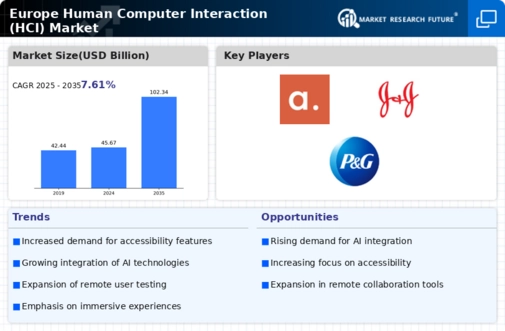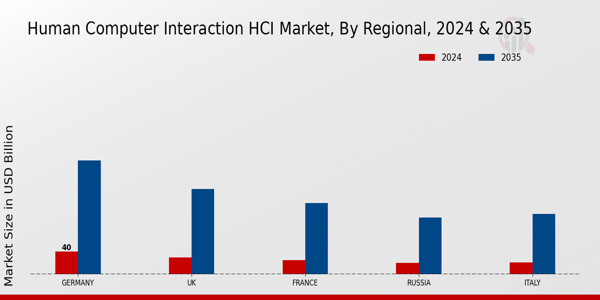Market Growth Visualization
Emergence of Wearable Technology
The emergence of wearable technology is reshaping the Global Europe Human Computer Interaction HCI Market Industry. Devices such as smartwatches and fitness trackers are becoming increasingly popular, prompting a demand for interfaces that facilitate seamless interaction between users and their devices. This trend indicates a shift towards more personalized and context-aware computing experiences. As wearable technology continues to evolve, the market is expected to grow, driven by innovations in sensor technology and data analytics. The integration of wearables into daily life suggests that the HCI market will adapt to accommodate these devices, potentially leading to new opportunities for developers and designers.
Growing Focus on User-Centric Design
User-centric design principles are gaining traction within the Global Europe Human Computer Interaction HCI Market Industry. As companies recognize the importance of tailoring products to meet user needs, there is a marked increase in the development of interfaces that prioritize usability and accessibility. This shift is likely to enhance user satisfaction and engagement, potentially leading to higher retention rates. The emphasis on user experience aligns with the projected growth of the market, which is expected to reach 102.34 USD Billion by 2035. Organizations are investing in research and development to create more intuitive designs, thereby fostering a culture of innovation that could reshape the landscape of human-computer interaction.
Increased Adoption of AI Technologies
The Global Europe Human Computer Interaction HCI Market Industry experiences a notable surge in the adoption of artificial intelligence technologies. As organizations increasingly integrate AI into their systems, the demand for intuitive interfaces that facilitate seamless human-computer interactions grows. This trend is evidenced by the projected market value of 45.67 USD Billion in 2024, reflecting a robust interest in enhancing user experience through intelligent systems. AI-driven applications, such as virtual assistants and chatbots, are becoming commonplace, indicating a shift towards more interactive and responsive interfaces. This evolution suggests that the market will continue to expand as businesses seek to leverage AI for improved efficiency and user engagement.
Rising Demand for Remote Work Solutions
The Global Europe Human Computer Interaction HCI Market Industry is witnessing a surge in demand for remote work solutions. As organizations adapt to evolving work environments, there is an increasing need for tools that facilitate effective communication and collaboration among remote teams. This trend is reflected in the market's projected compound annual growth rate of 7.61% from 2025 to 2035. Companies are investing in HCI technologies that enhance virtual collaboration, such as video conferencing tools and collaborative software, which are designed to improve user interaction and productivity. This growing emphasis on remote work solutions indicates a shift in how organizations approach human-computer interaction, potentially leading to long-term changes in workplace dynamics.
Advancements in Augmented and Virtual Reality
Advancements in augmented reality AR and virtual reality VR technologies are significantly influencing the Global Europe Human Computer Interaction HCI Market Industry. These technologies are transforming how users interact with digital environments, offering immersive experiences that enhance engagement and learning. The integration of AR and VR into various sectors, including education, healthcare, and entertainment, is driving innovation in HCI design. As these technologies become more mainstream, the market is likely to expand, reflecting the growing interest in creating more interactive and engaging user experiences. The potential for AR and VR applications suggests that the market will continue to evolve, catering to diverse user needs and preferences.





